Report on BSBWOR502: Leading and Managing Team Effectiveness
VerifiedAdded on 2022/11/30
|9
|2301
|237
Report
AI Summary
This report, focusing on BSBWOR502, delves into the core principles of leading and managing team effectiveness. It begins by defining the role of a team charter in aligning team goals with organizational objectives. The report then outlines the importance of establishing performance-oriented development plans, emphasizing the use of key performance indicators (KPIs) and the consideration of organizational resources. It explores strategies for motivating team members, including performance appraisals and providing guidance, and highlights the leader's role in fostering equal participation and communication. The report also addresses how to encourage team ownership, provide feedback, and resolve work performance issues. It further discusses strategies to increase team member engagement, support performance problem-solving, and model effective leadership. The report also covers the significance of maintaining open communication, communicating important information to line managers, and addressing unresolved issues. The report concludes by outlining actions to resolve issues raised by internal stakeholders, emphasizing the importance of evaluating concerns, setting timelines, and making informed decisions.
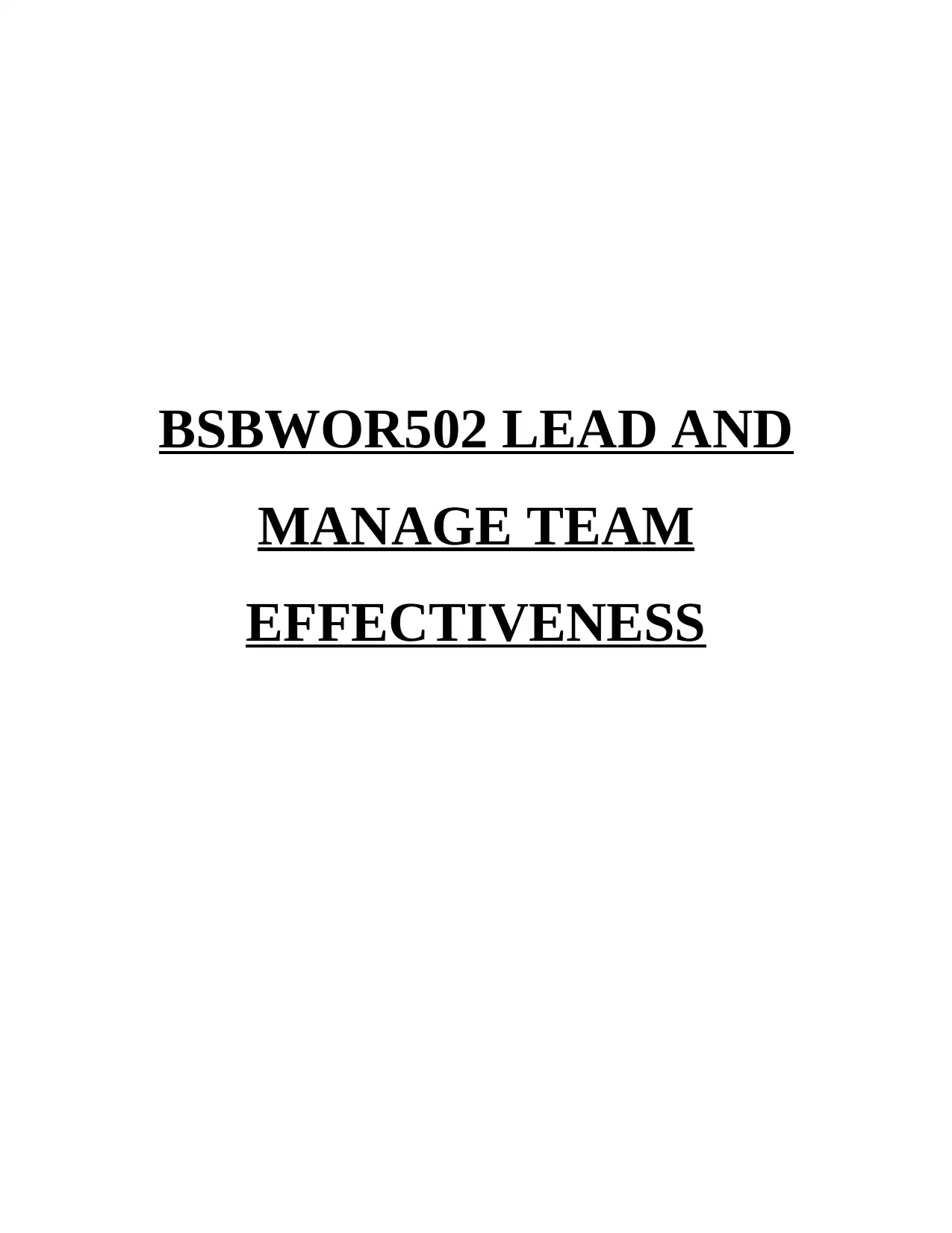
BSBWOR502 LEAD AND
MANAGE TEAM
EFFECTIVENESS
MANAGE TEAM
EFFECTIVENESS
Paraphrase This Document
Need a fresh take? Get an instant paraphrase of this document with our AI Paraphraser
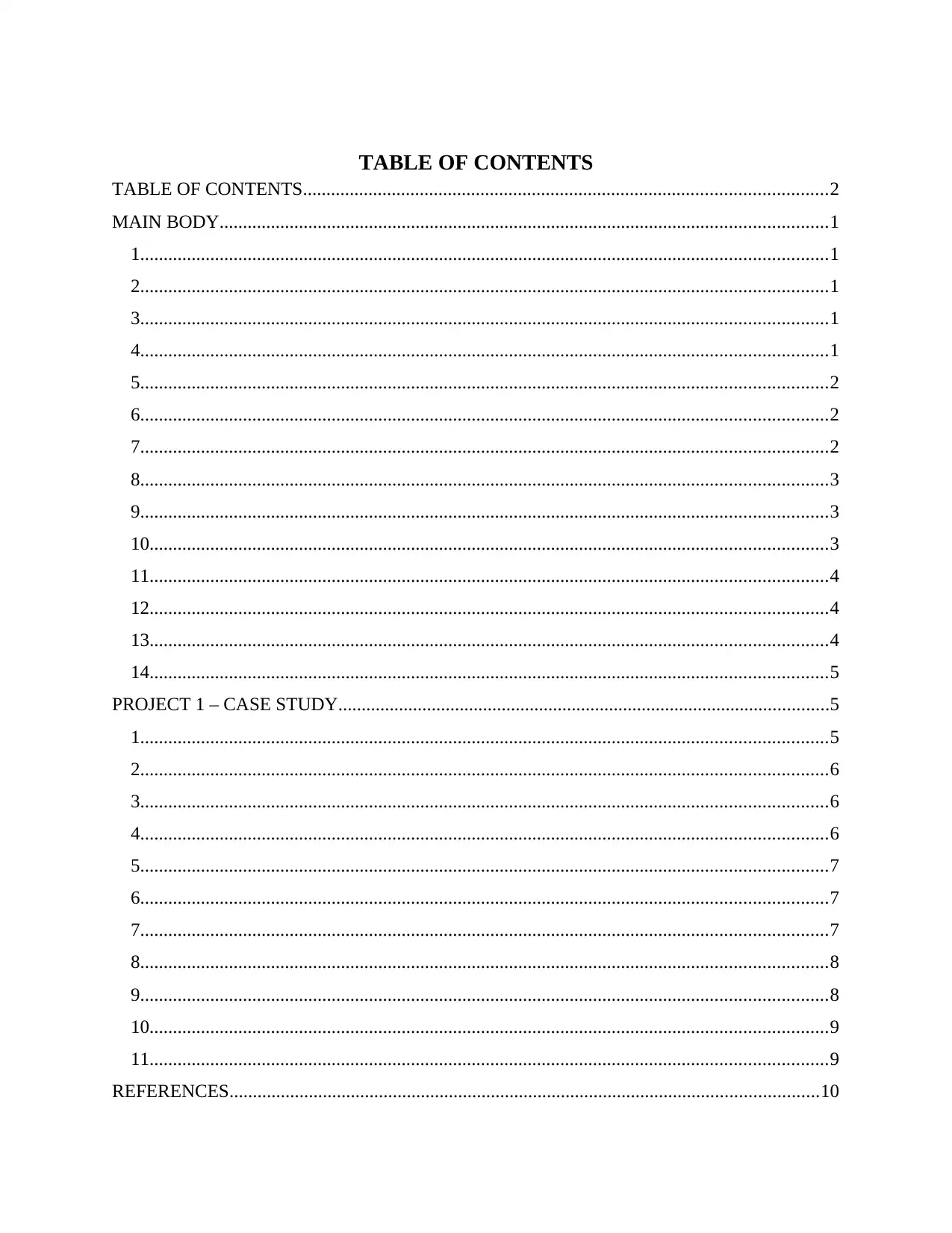
TABLE OF CONTENTS
TABLE OF CONTENTS................................................................................................................2
MAIN BODY..................................................................................................................................1
1...................................................................................................................................................1
2...................................................................................................................................................1
3...................................................................................................................................................1
4...................................................................................................................................................1
5...................................................................................................................................................2
6...................................................................................................................................................2
7...................................................................................................................................................2
8...................................................................................................................................................3
9...................................................................................................................................................3
10.................................................................................................................................................3
11.................................................................................................................................................4
12.................................................................................................................................................4
13.................................................................................................................................................4
14.................................................................................................................................................5
PROJECT 1 – CASE STUDY.........................................................................................................5
1...................................................................................................................................................5
2...................................................................................................................................................6
3...................................................................................................................................................6
4...................................................................................................................................................6
5...................................................................................................................................................7
6...................................................................................................................................................7
7...................................................................................................................................................7
8...................................................................................................................................................8
9...................................................................................................................................................8
10.................................................................................................................................................9
11.................................................................................................................................................9
REFERENCES..............................................................................................................................10
TABLE OF CONTENTS................................................................................................................2
MAIN BODY..................................................................................................................................1
1...................................................................................................................................................1
2...................................................................................................................................................1
3...................................................................................................................................................1
4...................................................................................................................................................1
5...................................................................................................................................................2
6...................................................................................................................................................2
7...................................................................................................................................................2
8...................................................................................................................................................3
9...................................................................................................................................................3
10.................................................................................................................................................3
11.................................................................................................................................................4
12.................................................................................................................................................4
13.................................................................................................................................................4
14.................................................................................................................................................5
PROJECT 1 – CASE STUDY.........................................................................................................5
1...................................................................................................................................................5
2...................................................................................................................................................6
3...................................................................................................................................................6
4...................................................................................................................................................6
5...................................................................................................................................................7
6...................................................................................................................................................7
7...................................................................................................................................................7
8...................................................................................................................................................8
9...................................................................................................................................................8
10.................................................................................................................................................9
11.................................................................................................................................................9
REFERENCES..............................................................................................................................10

⊘ This is a preview!⊘
Do you want full access?
Subscribe today to unlock all pages.

Trusted by 1+ million students worldwide
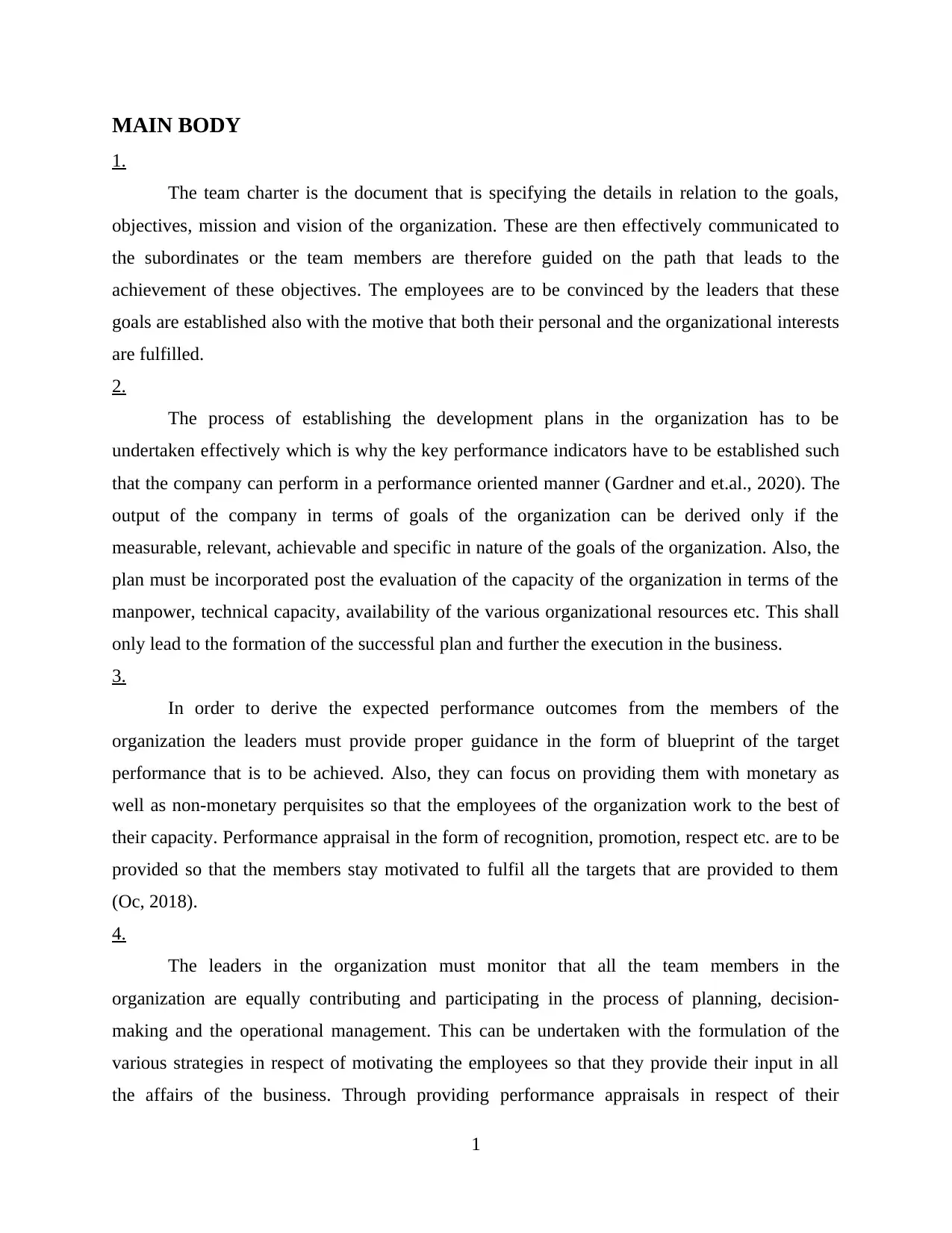
MAIN BODY
1.
The team charter is the document that is specifying the details in relation to the goals,
objectives, mission and vision of the organization. These are then effectively communicated to
the subordinates or the team members are therefore guided on the path that leads to the
achievement of these objectives. The employees are to be convinced by the leaders that these
goals are established also with the motive that both their personal and the organizational interests
are fulfilled.
2.
The process of establishing the development plans in the organization has to be
undertaken effectively which is why the key performance indicators have to be established such
that the company can perform in a performance oriented manner (Gardner and et.al., 2020). The
output of the company in terms of goals of the organization can be derived only if the
measurable, relevant, achievable and specific in nature of the goals of the organization. Also, the
plan must be incorporated post the evaluation of the capacity of the organization in terms of the
manpower, technical capacity, availability of the various organizational resources etc. This shall
only lead to the formation of the successful plan and further the execution in the business.
3.
In order to derive the expected performance outcomes from the members of the
organization the leaders must provide proper guidance in the form of blueprint of the target
performance that is to be achieved. Also, they can focus on providing them with monetary as
well as non-monetary perquisites so that the employees of the organization work to the best of
their capacity. Performance appraisal in the form of recognition, promotion, respect etc. are to be
provided so that the members stay motivated to fulfil all the targets that are provided to them
(Oc, 2018).
4.
The leaders in the organization must monitor that all the team members in the
organization are equally contributing and participating in the process of planning, decision-
making and the operational management. This can be undertaken with the formulation of the
various strategies in respect of motivating the employees so that they provide their input in all
the affairs of the business. Through providing performance appraisals in respect of their
1
1.
The team charter is the document that is specifying the details in relation to the goals,
objectives, mission and vision of the organization. These are then effectively communicated to
the subordinates or the team members are therefore guided on the path that leads to the
achievement of these objectives. The employees are to be convinced by the leaders that these
goals are established also with the motive that both their personal and the organizational interests
are fulfilled.
2.
The process of establishing the development plans in the organization has to be
undertaken effectively which is why the key performance indicators have to be established such
that the company can perform in a performance oriented manner (Gardner and et.al., 2020). The
output of the company in terms of goals of the organization can be derived only if the
measurable, relevant, achievable and specific in nature of the goals of the organization. Also, the
plan must be incorporated post the evaluation of the capacity of the organization in terms of the
manpower, technical capacity, availability of the various organizational resources etc. This shall
only lead to the formation of the successful plan and further the execution in the business.
3.
In order to derive the expected performance outcomes from the members of the
organization the leaders must provide proper guidance in the form of blueprint of the target
performance that is to be achieved. Also, they can focus on providing them with monetary as
well as non-monetary perquisites so that the employees of the organization work to the best of
their capacity. Performance appraisal in the form of recognition, promotion, respect etc. are to be
provided so that the members stay motivated to fulfil all the targets that are provided to them
(Oc, 2018).
4.
The leaders in the organization must monitor that all the team members in the
organization are equally contributing and participating in the process of planning, decision-
making and the operational management. This can be undertaken with the formulation of the
various strategies in respect of motivating the employees so that they provide their input in all
the affairs of the business. Through providing performance appraisals in respect of their
1
Paraphrase This Document
Need a fresh take? Get an instant paraphrase of this document with our AI Paraphraser
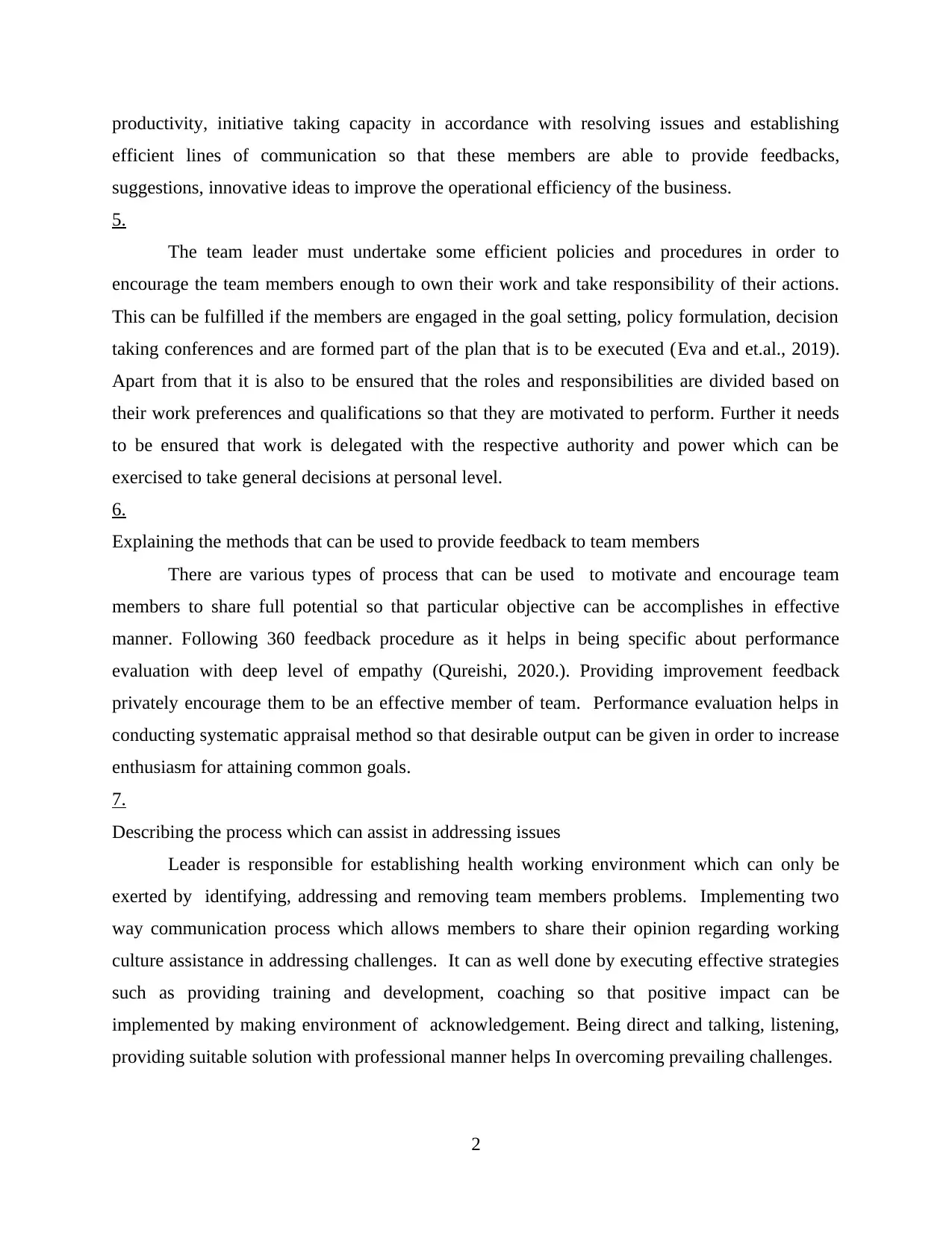
productivity, initiative taking capacity in accordance with resolving issues and establishing
efficient lines of communication so that these members are able to provide feedbacks,
suggestions, innovative ideas to improve the operational efficiency of the business.
5.
The team leader must undertake some efficient policies and procedures in order to
encourage the team members enough to own their work and take responsibility of their actions.
This can be fulfilled if the members are engaged in the goal setting, policy formulation, decision
taking conferences and are formed part of the plan that is to be executed (Eva and et.al., 2019).
Apart from that it is also to be ensured that the roles and responsibilities are divided based on
their work preferences and qualifications so that they are motivated to perform. Further it needs
to be ensured that work is delegated with the respective authority and power which can be
exercised to take general decisions at personal level.
6.
Explaining the methods that can be used to provide feedback to team members
There are various types of process that can be used to motivate and encourage team
members to share full potential so that particular objective can be accomplishes in effective
manner. Following 360 feedback procedure as it helps in being specific about performance
evaluation with deep level of empathy (Qureishi, 2020.). Providing improvement feedback
privately encourage them to be an effective member of team. Performance evaluation helps in
conducting systematic appraisal method so that desirable output can be given in order to increase
enthusiasm for attaining common goals.
7.
Describing the process which can assist in addressing issues
Leader is responsible for establishing health working environment which can only be
exerted by identifying, addressing and removing team members problems. Implementing two
way communication process which allows members to share their opinion regarding working
culture assistance in addressing challenges. It can as well done by executing effective strategies
such as providing training and development, coaching so that positive impact can be
implemented by making environment of acknowledgement. Being direct and talking, listening,
providing suitable solution with professional manner helps In overcoming prevailing challenges.
2
efficient lines of communication so that these members are able to provide feedbacks,
suggestions, innovative ideas to improve the operational efficiency of the business.
5.
The team leader must undertake some efficient policies and procedures in order to
encourage the team members enough to own their work and take responsibility of their actions.
This can be fulfilled if the members are engaged in the goal setting, policy formulation, decision
taking conferences and are formed part of the plan that is to be executed (Eva and et.al., 2019).
Apart from that it is also to be ensured that the roles and responsibilities are divided based on
their work preferences and qualifications so that they are motivated to perform. Further it needs
to be ensured that work is delegated with the respective authority and power which can be
exercised to take general decisions at personal level.
6.
Explaining the methods that can be used to provide feedback to team members
There are various types of process that can be used to motivate and encourage team
members to share full potential so that particular objective can be accomplishes in effective
manner. Following 360 feedback procedure as it helps in being specific about performance
evaluation with deep level of empathy (Qureishi, 2020.). Providing improvement feedback
privately encourage them to be an effective member of team. Performance evaluation helps in
conducting systematic appraisal method so that desirable output can be given in order to increase
enthusiasm for attaining common goals.
7.
Describing the process which can assist in addressing issues
Leader is responsible for establishing health working environment which can only be
exerted by identifying, addressing and removing team members problems. Implementing two
way communication process which allows members to share their opinion regarding working
culture assistance in addressing challenges. It can as well done by executing effective strategies
such as providing training and development, coaching so that positive impact can be
implemented by making environment of acknowledgement. Being direct and talking, listening,
providing suitable solution with professional manner helps In overcoming prevailing challenges.
2
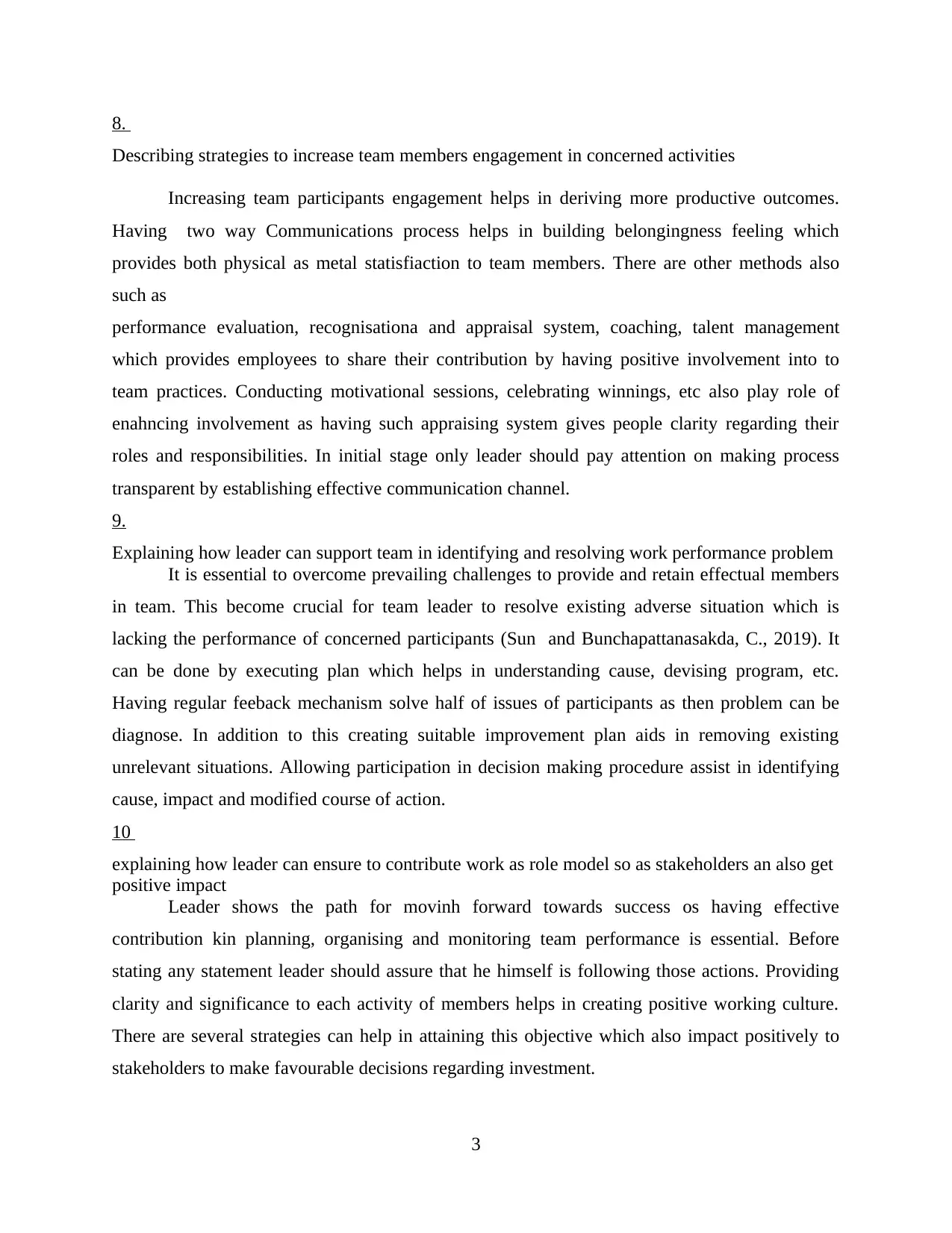
8.
Describing strategies to increase team members engagement in concerned activities
Increasing team participants engagement helps in deriving more productive outcomes.
Having two way Communications process helps in building belongingness feeling which
provides both physical as metal statisfiaction to team members. There are other methods also
such as
performance evaluation, recognisationa and appraisal system, coaching, talent management
which provides employees to share their contribution by having positive involvement into to
team practices. Conducting motivational sessions, celebrating winnings, etc also play role of
enahncing involvement as having such appraising system gives people clarity regarding their
roles and responsibilities. In initial stage only leader should pay attention on making process
transparent by establishing effective communication channel.
9.
Explaining how leader can support team in identifying and resolving work performance problem
It is essential to overcome prevailing challenges to provide and retain effectual members
in team. This become crucial for team leader to resolve existing adverse situation which is
lacking the performance of concerned participants (Sun and Bunchapattanasakda, C., 2019). It
can be done by executing plan which helps in understanding cause, devising program, etc.
Having regular feeback mechanism solve half of issues of participants as then problem can be
diagnose. In addition to this creating suitable improvement plan aids in removing existing
unrelevant situations. Allowing participation in decision making procedure assist in identifying
cause, impact and modified course of action.
10
explaining how leader can ensure to contribute work as role model so as stakeholders an also get
positive impact
Leader shows the path for movinh forward towards success os having effective
contribution kin planning, organising and monitoring team performance is essential. Before
stating any statement leader should assure that he himself is following those actions. Providing
clarity and significance to each activity of members helps in creating positive working culture.
There are several strategies can help in attaining this objective which also impact positively to
stakeholders to make favourable decisions regarding investment.
3
Describing strategies to increase team members engagement in concerned activities
Increasing team participants engagement helps in deriving more productive outcomes.
Having two way Communications process helps in building belongingness feeling which
provides both physical as metal statisfiaction to team members. There are other methods also
such as
performance evaluation, recognisationa and appraisal system, coaching, talent management
which provides employees to share their contribution by having positive involvement into to
team practices. Conducting motivational sessions, celebrating winnings, etc also play role of
enahncing involvement as having such appraising system gives people clarity regarding their
roles and responsibilities. In initial stage only leader should pay attention on making process
transparent by establishing effective communication channel.
9.
Explaining how leader can support team in identifying and resolving work performance problem
It is essential to overcome prevailing challenges to provide and retain effectual members
in team. This become crucial for team leader to resolve existing adverse situation which is
lacking the performance of concerned participants (Sun and Bunchapattanasakda, C., 2019). It
can be done by executing plan which helps in understanding cause, devising program, etc.
Having regular feeback mechanism solve half of issues of participants as then problem can be
diagnose. In addition to this creating suitable improvement plan aids in removing existing
unrelevant situations. Allowing participation in decision making procedure assist in identifying
cause, impact and modified course of action.
10
explaining how leader can ensure to contribute work as role model so as stakeholders an also get
positive impact
Leader shows the path for movinh forward towards success os having effective
contribution kin planning, organising and monitoring team performance is essential. Before
stating any statement leader should assure that he himself is following those actions. Providing
clarity and significance to each activity of members helps in creating positive working culture.
There are several strategies can help in attaining this objective which also impact positively to
stakeholders to make favourable decisions regarding investment.
3
⊘ This is a preview!⊘
Do you want full access?
Subscribe today to unlock all pages.

Trusted by 1+ million students worldwide
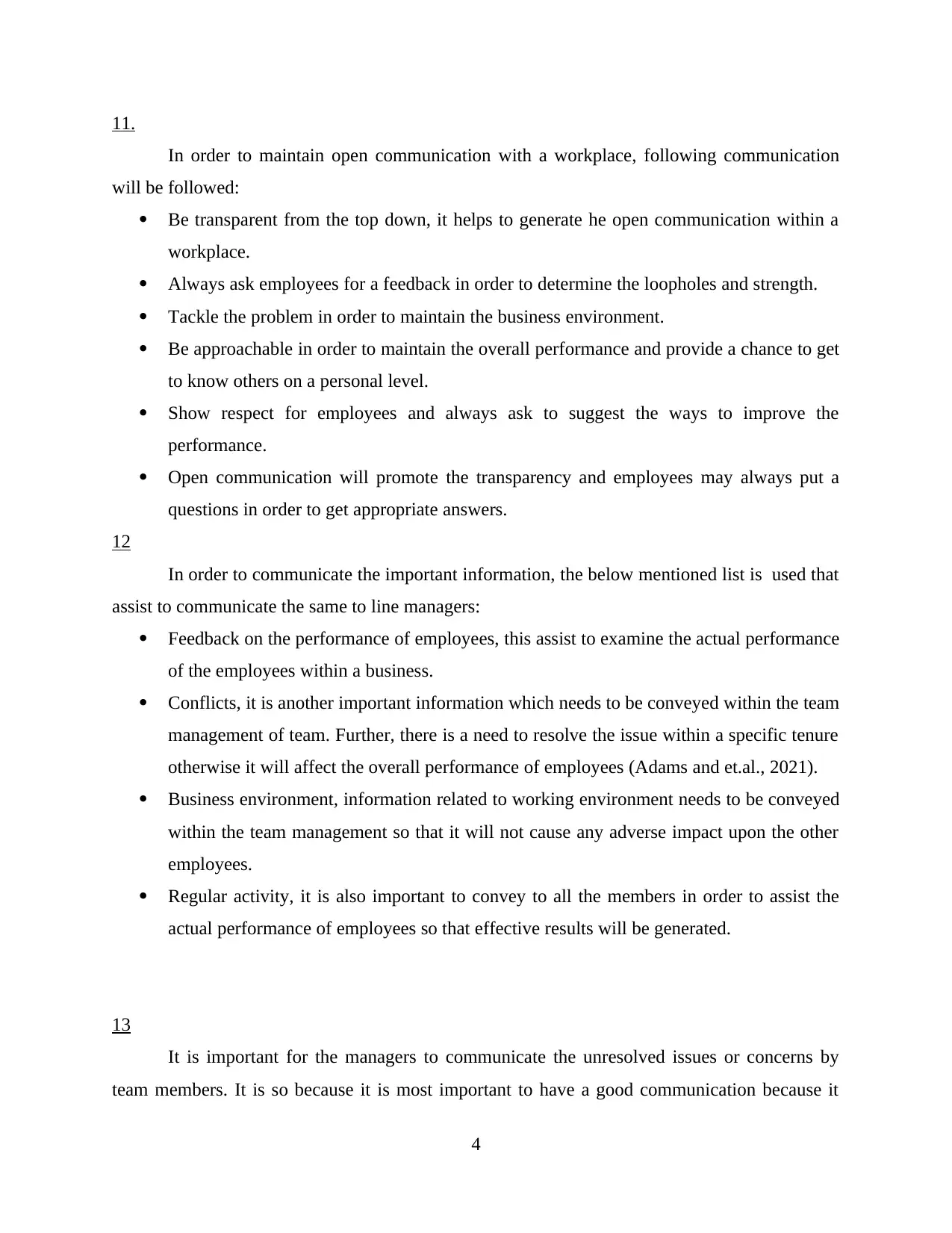
11.
In order to maintain open communication with a workplace, following communication
will be followed:
Be transparent from the top down, it helps to generate he open communication within a
workplace.
Always ask employees for a feedback in order to determine the loopholes and strength.
Tackle the problem in order to maintain the business environment.
Be approachable in order to maintain the overall performance and provide a chance to get
to know others on a personal level.
Show respect for employees and always ask to suggest the ways to improve the
performance.
Open communication will promote the transparency and employees may always put a
questions in order to get appropriate answers.
12
In order to communicate the important information, the below mentioned list is used that
assist to communicate the same to line managers:
Feedback on the performance of employees, this assist to examine the actual performance
of the employees within a business.
Conflicts, it is another important information which needs to be conveyed within the team
management of team. Further, there is a need to resolve the issue within a specific tenure
otherwise it will affect the overall performance of employees (Adams and et.al., 2021).
Business environment, information related to working environment needs to be conveyed
within the team management so that it will not cause any adverse impact upon the other
employees.
Regular activity, it is also important to convey to all the members in order to assist the
actual performance of employees so that effective results will be generated.
13
It is important for the managers to communicate the unresolved issues or concerns by
team members. It is so because it is most important to have a good communication because it
4
In order to maintain open communication with a workplace, following communication
will be followed:
Be transparent from the top down, it helps to generate he open communication within a
workplace.
Always ask employees for a feedback in order to determine the loopholes and strength.
Tackle the problem in order to maintain the business environment.
Be approachable in order to maintain the overall performance and provide a chance to get
to know others on a personal level.
Show respect for employees and always ask to suggest the ways to improve the
performance.
Open communication will promote the transparency and employees may always put a
questions in order to get appropriate answers.
12
In order to communicate the important information, the below mentioned list is used that
assist to communicate the same to line managers:
Feedback on the performance of employees, this assist to examine the actual performance
of the employees within a business.
Conflicts, it is another important information which needs to be conveyed within the team
management of team. Further, there is a need to resolve the issue within a specific tenure
otherwise it will affect the overall performance of employees (Adams and et.al., 2021).
Business environment, information related to working environment needs to be conveyed
within the team management so that it will not cause any adverse impact upon the other
employees.
Regular activity, it is also important to convey to all the members in order to assist the
actual performance of employees so that effective results will be generated.
13
It is important for the managers to communicate the unresolved issues or concerns by
team members. It is so because it is most important to have a good communication because it
4
Paraphrase This Document
Need a fresh take? Get an instant paraphrase of this document with our AI Paraphraser
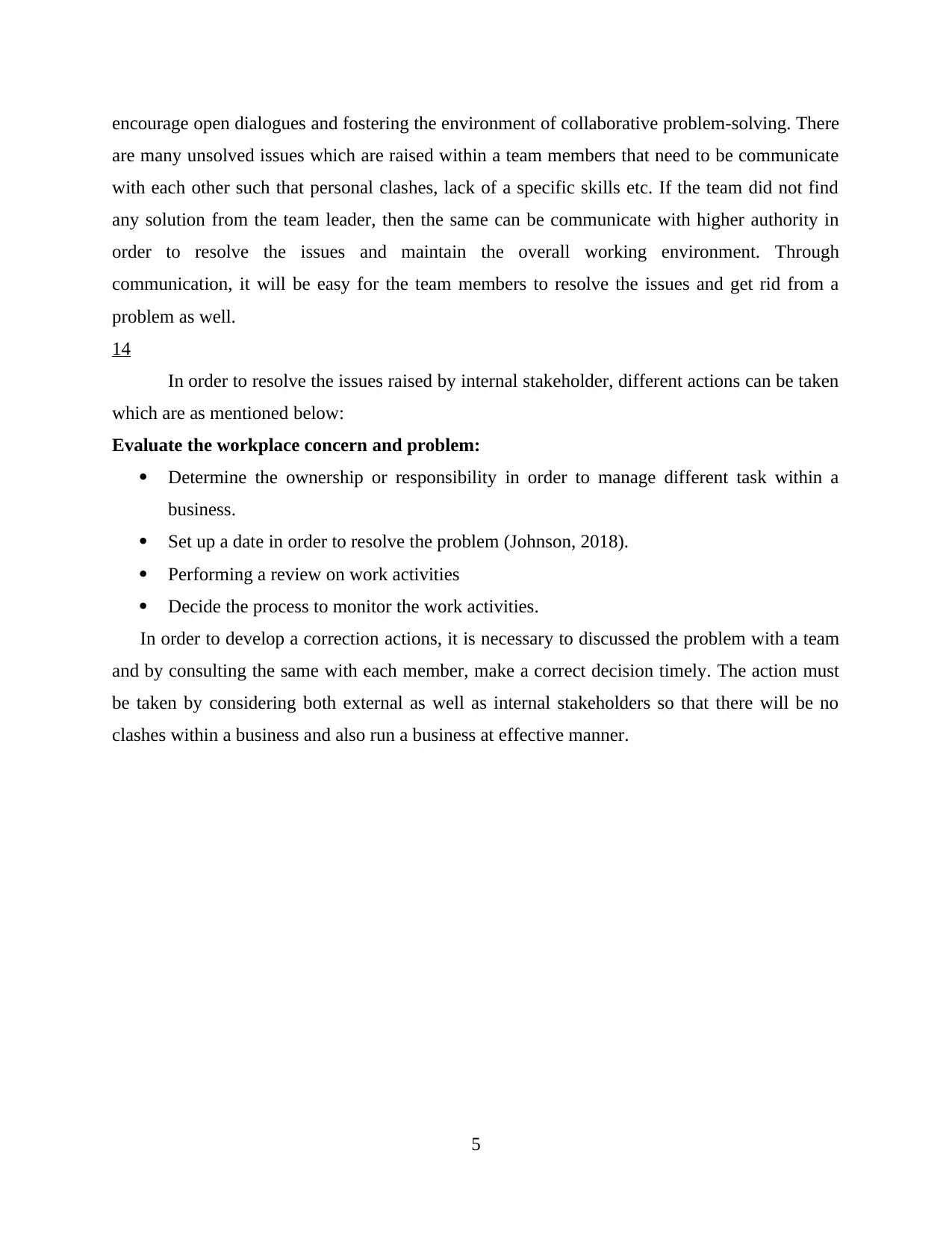
encourage open dialogues and fostering the environment of collaborative problem-solving. There
are many unsolved issues which are raised within a team members that need to be communicate
with each other such that personal clashes, lack of a specific skills etc. If the team did not find
any solution from the team leader, then the same can be communicate with higher authority in
order to resolve the issues and maintain the overall working environment. Through
communication, it will be easy for the team members to resolve the issues and get rid from a
problem as well.
14
In order to resolve the issues raised by internal stakeholder, different actions can be taken
which are as mentioned below:
Evaluate the workplace concern and problem:
Determine the ownership or responsibility in order to manage different task within a
business.
Set up a date in order to resolve the problem (Johnson, 2018).
Performing a review on work activities
Decide the process to monitor the work activities.
In order to develop a correction actions, it is necessary to discussed the problem with a team
and by consulting the same with each member, make a correct decision timely. The action must
be taken by considering both external as well as internal stakeholders so that there will be no
clashes within a business and also run a business at effective manner.
5
are many unsolved issues which are raised within a team members that need to be communicate
with each other such that personal clashes, lack of a specific skills etc. If the team did not find
any solution from the team leader, then the same can be communicate with higher authority in
order to resolve the issues and maintain the overall working environment. Through
communication, it will be easy for the team members to resolve the issues and get rid from a
problem as well.
14
In order to resolve the issues raised by internal stakeholder, different actions can be taken
which are as mentioned below:
Evaluate the workplace concern and problem:
Determine the ownership or responsibility in order to manage different task within a
business.
Set up a date in order to resolve the problem (Johnson, 2018).
Performing a review on work activities
Decide the process to monitor the work activities.
In order to develop a correction actions, it is necessary to discussed the problem with a team
and by consulting the same with each member, make a correct decision timely. The action must
be taken by considering both external as well as internal stakeholders so that there will be no
clashes within a business and also run a business at effective manner.
5
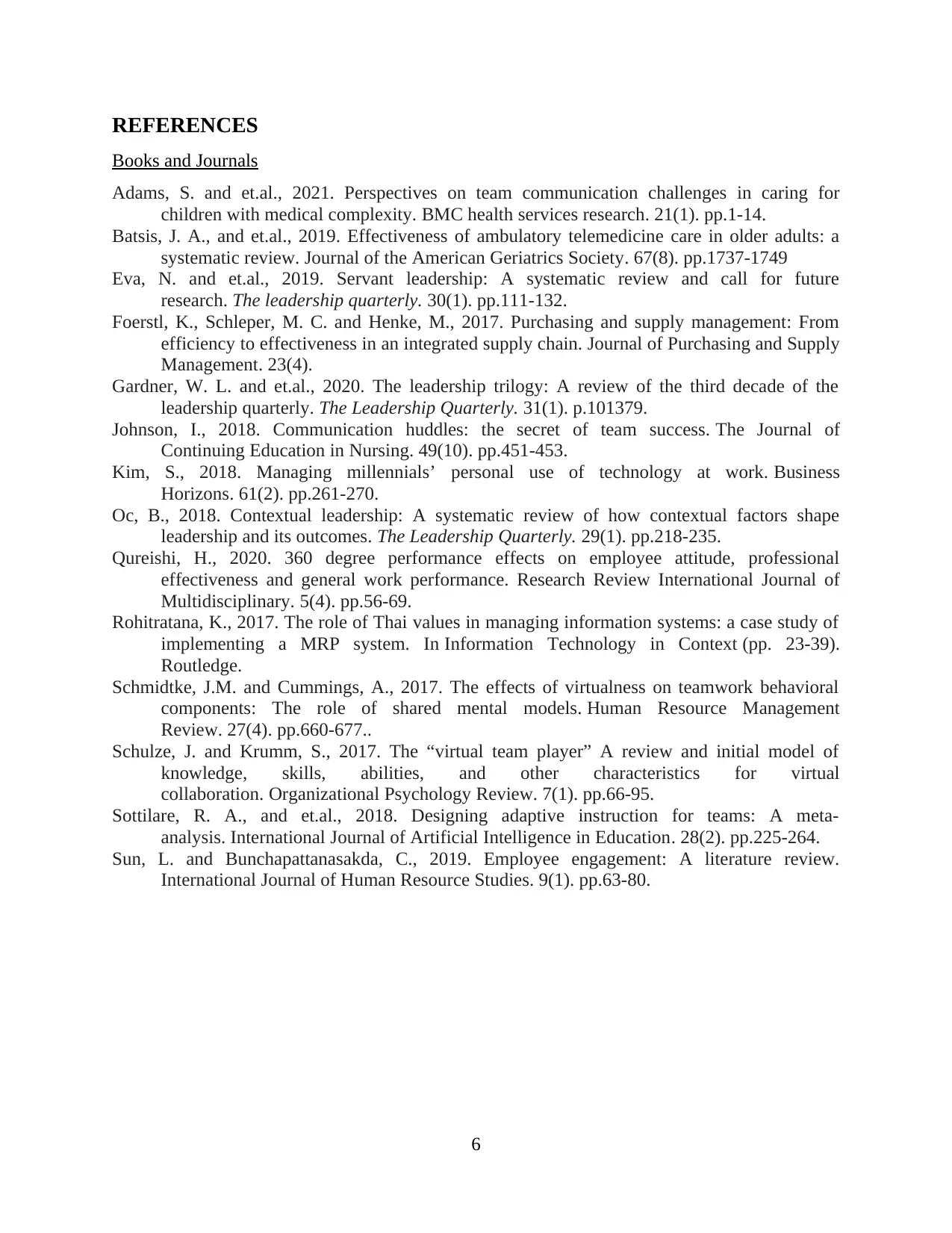
REFERENCES
Books and Journals
Adams, S. and et.al., 2021. Perspectives on team communication challenges in caring for
children with medical complexity. BMC health services research. 21(1). pp.1-14.
Batsis, J. A., and et.al., 2019. Effectiveness of ambulatory telemedicine care in older adults: a
systematic review. Journal of the American Geriatrics Society. 67(8). pp.1737-1749
Eva, N. and et.al., 2019. Servant leadership: A systematic review and call for future
research. The leadership quarterly. 30(1). pp.111-132.
Foerstl, K., Schleper, M. C. and Henke, M., 2017. Purchasing and supply management: From
efficiency to effectiveness in an integrated supply chain. Journal of Purchasing and Supply
Management. 23(4).
Gardner, W. L. and et.al., 2020. The leadership trilogy: A review of the third decade of the
leadership quarterly. The Leadership Quarterly. 31(1). p.101379.
Johnson, I., 2018. Communication huddles: the secret of team success. The Journal of
Continuing Education in Nursing. 49(10). pp.451-453.
Kim, S., 2018. Managing millennials’ personal use of technology at work. Business
Horizons. 61(2). pp.261-270.
Oc, B., 2018. Contextual leadership: A systematic review of how contextual factors shape
leadership and its outcomes. The Leadership Quarterly. 29(1). pp.218-235.
Qureishi, H., 2020. 360 degree performance effects on employee attitude, professional
effectiveness and general work performance. Research Review International Journal of
Multidisciplinary. 5(4). pp.56-69.
Rohitratana, K., 2017. The role of Thai values in managing information systems: a case study of
implementing a MRP system. In Information Technology in Context (pp. 23-39).
Routledge.
Schmidtke, J.M. and Cummings, A., 2017. The effects of virtualness on teamwork behavioral
components: The role of shared mental models. Human Resource Management
Review. 27(4). pp.660-677..
Schulze, J. and Krumm, S., 2017. The “virtual team player” A review and initial model of
knowledge, skills, abilities, and other characteristics for virtual
collaboration. Organizational Psychology Review. 7(1). pp.66-95.
Sottilare, R. A., and et.al., 2018. Designing adaptive instruction for teams: A meta-
analysis. International Journal of Artificial Intelligence in Education. 28(2). pp.225-264.
Sun, L. and Bunchapattanasakda, C., 2019. Employee engagement: A literature review.
International Journal of Human Resource Studies. 9(1). pp.63-80.
6
Books and Journals
Adams, S. and et.al., 2021. Perspectives on team communication challenges in caring for
children with medical complexity. BMC health services research. 21(1). pp.1-14.
Batsis, J. A., and et.al., 2019. Effectiveness of ambulatory telemedicine care in older adults: a
systematic review. Journal of the American Geriatrics Society. 67(8). pp.1737-1749
Eva, N. and et.al., 2019. Servant leadership: A systematic review and call for future
research. The leadership quarterly. 30(1). pp.111-132.
Foerstl, K., Schleper, M. C. and Henke, M., 2017. Purchasing and supply management: From
efficiency to effectiveness in an integrated supply chain. Journal of Purchasing and Supply
Management. 23(4).
Gardner, W. L. and et.al., 2020. The leadership trilogy: A review of the third decade of the
leadership quarterly. The Leadership Quarterly. 31(1). p.101379.
Johnson, I., 2018. Communication huddles: the secret of team success. The Journal of
Continuing Education in Nursing. 49(10). pp.451-453.
Kim, S., 2018. Managing millennials’ personal use of technology at work. Business
Horizons. 61(2). pp.261-270.
Oc, B., 2018. Contextual leadership: A systematic review of how contextual factors shape
leadership and its outcomes. The Leadership Quarterly. 29(1). pp.218-235.
Qureishi, H., 2020. 360 degree performance effects on employee attitude, professional
effectiveness and general work performance. Research Review International Journal of
Multidisciplinary. 5(4). pp.56-69.
Rohitratana, K., 2017. The role of Thai values in managing information systems: a case study of
implementing a MRP system. In Information Technology in Context (pp. 23-39).
Routledge.
Schmidtke, J.M. and Cummings, A., 2017. The effects of virtualness on teamwork behavioral
components: The role of shared mental models. Human Resource Management
Review. 27(4). pp.660-677..
Schulze, J. and Krumm, S., 2017. The “virtual team player” A review and initial model of
knowledge, skills, abilities, and other characteristics for virtual
collaboration. Organizational Psychology Review. 7(1). pp.66-95.
Sottilare, R. A., and et.al., 2018. Designing adaptive instruction for teams: A meta-
analysis. International Journal of Artificial Intelligence in Education. 28(2). pp.225-264.
Sun, L. and Bunchapattanasakda, C., 2019. Employee engagement: A literature review.
International Journal of Human Resource Studies. 9(1). pp.63-80.
6
⊘ This is a preview!⊘
Do you want full access?
Subscribe today to unlock all pages.

Trusted by 1+ million students worldwide
1 out of 9
Related Documents
Your All-in-One AI-Powered Toolkit for Academic Success.
+13062052269
info@desklib.com
Available 24*7 on WhatsApp / Email
![[object Object]](/_next/static/media/star-bottom.7253800d.svg)
Unlock your academic potential
Copyright © 2020–2025 A2Z Services. All Rights Reserved. Developed and managed by ZUCOL.





